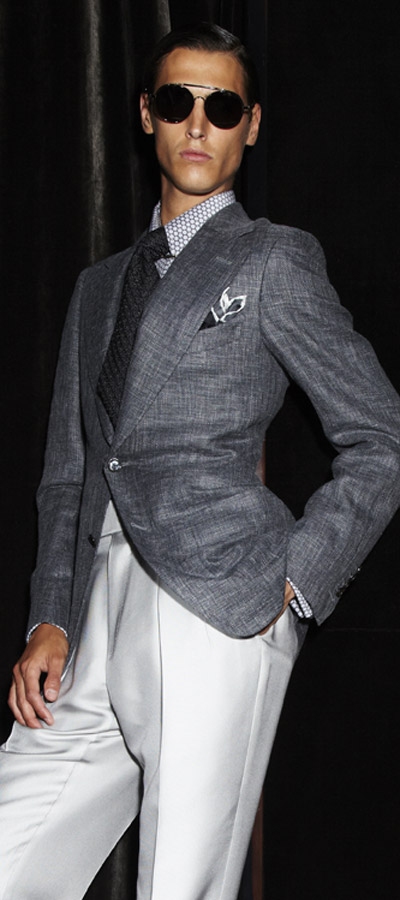
Thursday 31 May 2012
the mod one button
 Take note from the cult Mod movement, depicted in the new adaptation of the classic film Brighton Rock . The film is set in 1960'sBrighton ,
Take note from the cult Mod movement, depicted in the new adaptation of the classic film Brighton Rock . The film is set in 1960'sBrighton ,  which shows the mods and rocker riots on Brighton beach. The cast include Sam Riley, Helen Mirren and Andrea Riseborough.
which shows the mods and rocker riots on Brighton beach. The cast include Sam Riley, Helen Mirren and Andrea Riseborough.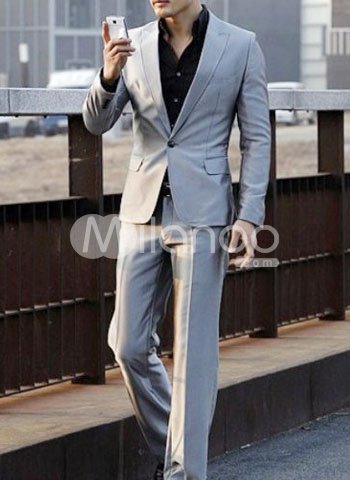
Mod fashion is about creating a simple, sharp silhouette - meaning a tailored slim cut suit in a Mohair tonic suit paired with a super sharp shirt.  This will certainly make you stand out from the crowd. We've a fantastic selection of beautiful lightweight fabrics with a slight shimmer, is a particular favorite of mine! is a blue and pale yellow medium weight wool, silk and linen mix.
This will certainly make you stand out from the crowd. We've a fantastic selection of beautiful lightweight fabrics with a slight shimmer, is a particular favorite of mine! is a blue and pale yellow medium weight wool, silk and linen mix.  The fabric is woven with two high contrast colours giving it a vibrant tonic effect. Sharkskin is another of my favorites, it's a
The fabric is woven with two high contrast colours giving it a vibrant tonic effect. Sharkskin is another of my favorites, it's a 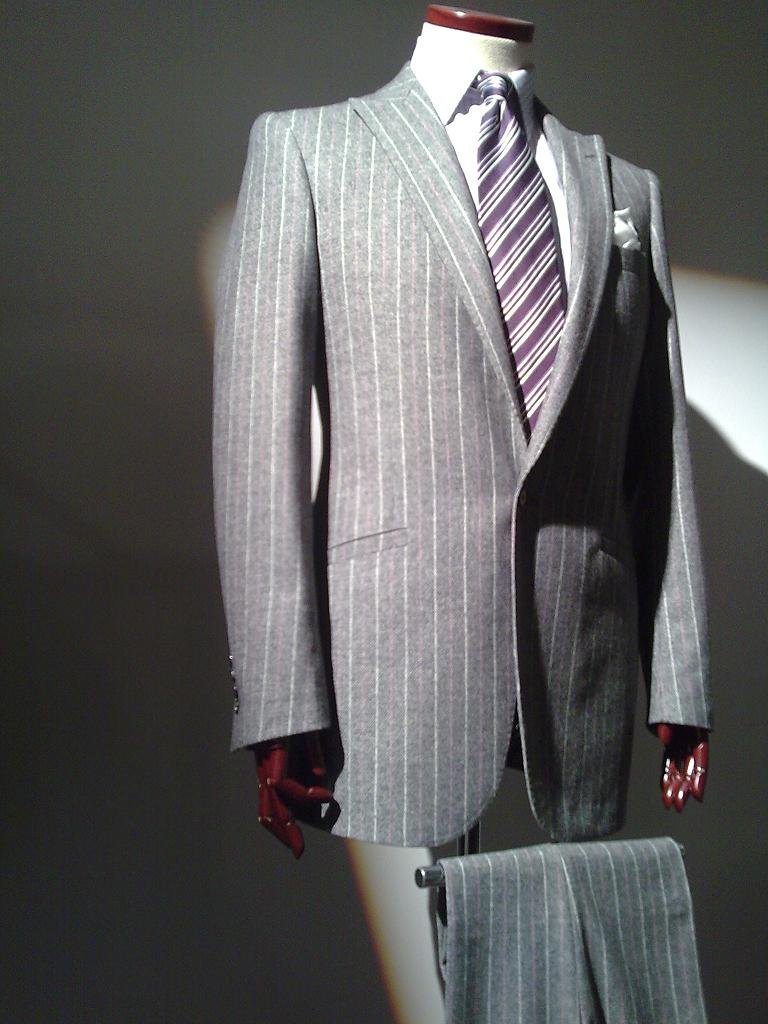 light weight, grey fabric, with a tonic weave - perfect for all seasons.
light weight, grey fabric, with a tonic weave - perfect for all seasons.
The Mod look is certainly a favorite of mine at the moment, particularly when worn with a skinny tie - which sets off the 60's inspired trend! This will certainly make you stand out from the crowd. We've a fantastic selection of beautiful lightweight fabrics with a slight shimmer, is a particular favorite of mine! is a blue and pale yellow medium weight wool, silk and linen mix.
This will certainly make you stand out from the crowd. We've a fantastic selection of beautiful lightweight fabrics with a slight shimmer, is a particular favorite of mine! is a blue and pale yellow medium weight wool, silk and linen mix.  The fabric is woven with two high contrast colours giving it a vibrant tonic effect. Sharkskin is another of my favorites, it's a
The fabric is woven with two high contrast colours giving it a vibrant tonic effect. Sharkskin is another of my favorites, it's a  light weight, grey fabric, with a tonic weave - perfect for all seasons.
light weight, grey fabric, with a tonic weave - perfect for all seasons.

 During these times of belt (or hip adjuster!) tightening, it is important to remember that one can breathe new life into wardrobe staples by simply adding a bit of colour. By this I mean accessorising an existing suit with a different colour palette, to give it a new lease of life, which is where the simple shirt can often come in handy.Although a bespoke suit is a thing of beauty, in which one cannot help but feel slightly regal, it is not in contact your skin like a shirt is, and we must not overlook the humble shirt. In fact, I might even go as far as to say that a bespoke shirt is the ultimate luxury! When cut correctly, in a shirting fabric that you love, in a shade that is flattering, it really is like a second skin.
During these times of belt (or hip adjuster!) tightening, it is important to remember that one can breathe new life into wardrobe staples by simply adding a bit of colour. By this I mean accessorising an existing suit with a different colour palette, to give it a new lease of life, which is where the simple shirt can often come in handy.Although a bespoke suit is a thing of beauty, in which one cannot help but feel slightly regal, it is not in contact your skin like a shirt is, and we must not overlook the humble shirt. In fact, I might even go as far as to say that a bespoke shirt is the ultimate luxury! When cut correctly, in a shirting fabric that you love, in a shade that is flattering, it really is like a second skin.futurians
The Futurians were a group of science fiction fans, many of whom became editors and writers as well. The Futurians were based in New York City and were a major force in the development of science fiction writing and science fiction fandom in the years 1937-1945As described in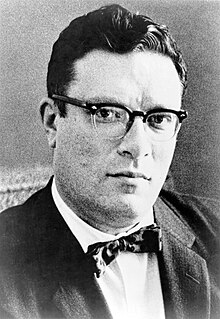 Isaac Asimov's autobiography In Memory Yet Green, the Futurians spun off from the Greater New York Science Fiction Club (headed by Sam Moskowitz, later an influential SF editor and historian) over ideological differences, with the Futurians wishing to take a more overt political stance. Other sources indicate that Donald A. Wollheim was pushing for a more left-wing direction with a goal of leading fandom toward a political ideal, all of which Moskowitz resisted. As a result, Wollheim broke off from the Greater New York group and founded the Futurians in September, 1938.The fans following Moskowitz reorganized into the Queens Science Fiction Club.
Isaac Asimov's autobiography In Memory Yet Green, the Futurians spun off from the Greater New York Science Fiction Club (headed by Sam Moskowitz, later an influential SF editor and historian) over ideological differences, with the Futurians wishing to take a more overt political stance. Other sources indicate that Donald A. Wollheim was pushing for a more left-wing direction with a goal of leading fandom toward a political ideal, all of which Moskowitz resisted. As a result, Wollheim broke off from the Greater New York group and founded the Futurians in September, 1938.The fans following Moskowitz reorganized into the Queens Science Fiction Club.
 Isaac Asimov's autobiography In Memory Yet Green, the Futurians spun off from the Greater New York Science Fiction Club (headed by Sam Moskowitz, later an influential SF editor and historian) over ideological differences, with the Futurians wishing to take a more overt political stance. Other sources indicate that Donald A. Wollheim was pushing for a more left-wing direction with a goal of leading fandom toward a political ideal, all of which Moskowitz resisted. As a result, Wollheim broke off from the Greater New York group and founded the Futurians in September, 1938.The fans following Moskowitz reorganized into the Queens Science Fiction Club.
Isaac Asimov's autobiography In Memory Yet Green, the Futurians spun off from the Greater New York Science Fiction Club (headed by Sam Moskowitz, later an influential SF editor and historian) over ideological differences, with the Futurians wishing to take a more overt political stance. Other sources indicate that Donald A. Wollheim was pushing for a more left-wing direction with a goal of leading fandom toward a political ideal, all of which Moskowitz resisted. As a result, Wollheim broke off from the Greater New York group and founded the Futurians in September, 1938.The fans following Moskowitz reorganized into the Queens Science Fiction Club.Frederik Pohl, in his autobiography The Way the Future Was, said that the origins of the Futurians started with the Science Fiction League founded by Hugo Gernsback
said that the origins of the Futurians started with the Science Fiction League founded by Hugo Gernsback in 1934, the New York City local chapter of which was called the "Brooklyn Science Fiction League" or BSFL, and headed by G. G. Clark.
in 1934, the New York City local chapter of which was called the "Brooklyn Science Fiction League" or BSFL, and headed by G. G. Clark.
 said that the origins of the Futurians started with the Science Fiction League founded by Hugo Gernsback
said that the origins of the Futurians started with the Science Fiction League founded by Hugo Gernsback in 1934, the New York City local chapter of which was called the "Brooklyn Science Fiction League" or BSFL, and headed by G. G. Clark.
in 1934, the New York City local chapter of which was called the "Brooklyn Science Fiction League" or BSFL, and headed by G. G. Clark.Wollheim, John Michel, and Robert A. W. Lowndes were also members of the BSFL. Along with Pohl, the four started calling themselves the "Quadrumvirate". Pohl, commenting about that time, said "we four marched from Brooklyn to the sea, leaving a wide scar of burned out clubs behind us. We changed clubs the way Detroit changes tailfins, every year had a new one, and last year's was junk".
There were several club names during that period, before finally settling on the Futurians. In 1935 there was the "East New York Science Fiction League" (ENYSFL), later the "Independent League for Science Fiction" (ILSF). In 1936 came the International Cosmos Science Club (ICSC), which also involved Will Sykora. Pohl then says that "on reflection 'Cosmos' seemed to take in a bit more territory than was justified, so we changed it to the International Scientific Association (it wasn't International either, but then it also wasn't scientific)". The ISA then was renamed New York Branch-International Scientific Association (NYB-ISA).
In 1937, after the falling out with Will Sykora and others, the "Quadrumvirate" went on to found the Futurians. Will Sykora then founded the Queens Science Fiction League with Sam Moskowitz and James V. Taurasi. Later, the QSFL changed into New Fandom. Pohl said as the conflicts between New Fandom and the Futurians were "Addicted to Feuds" and that "NoCIA nor KGB ever wrestled so valiantly for the soul of an emerging nation as New Fandom and the Futurians did for science fiction".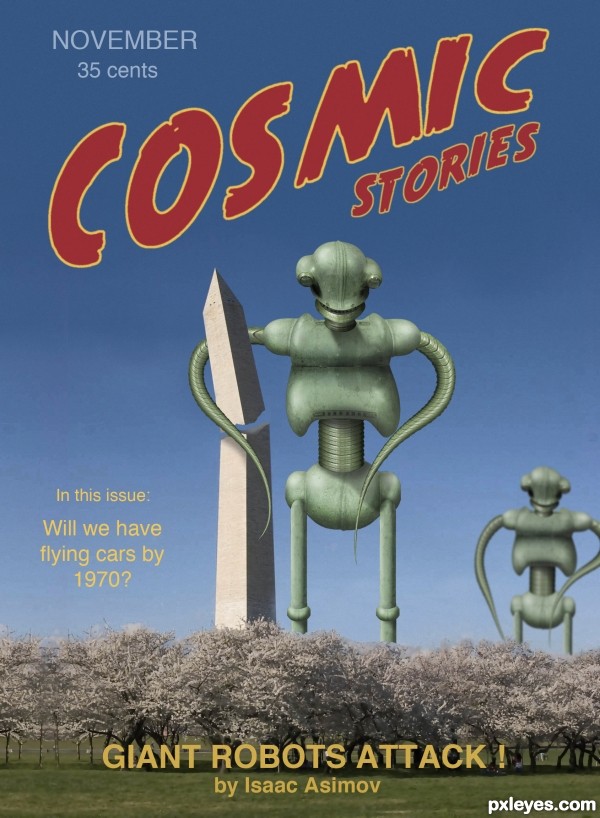

Most of the group's members also had professional ambitions within science fiction and related fields, and collectively were very effective at achieving this goal, as the roster of members below suggests. At one point in the earliest 1940s, approximately half of all the pulp sf and fantasy magazines in the U.S. were being edited by Futurians: Frederik Pohl at the Popular Publications offshoot Fictioneers, Inc. (Astonishing Stories and Super-Science Stories); Robert Lowndes at Columbia Publications, most notably with Science Fiction and Future Fiction(though through the decade to come, Lowndes's responsibilities would expand to other types of fiction magazine in the chain), and Donald Wollheim at the very marginal Albing Publications with the short-lived, micro-budgeted Cosmic Stories and Stirring Science Stories (Wollheim soon moved on to  Avon Books; Doë "Leslie Perri" Baumgardt also worked on a romance fiction title for Albing). Most of these projects had small editorial budgets, and relied in part, or occasionally entirely, on contributions from fellow Futurians for their contents.At the time the Futurians were formed, Donald Wollheim was strongly attracted by communism and believed that followers of science fiction "should actively work for the realization of the scientific world-state as the only genuine justification for their activities and existence".[ It was to this end that Wollheim formed the Futurians, and many of its members were in some degree interested in the political applications of science fiction.
Avon Books; Doë "Leslie Perri" Baumgardt also worked on a romance fiction title for Albing). Most of these projects had small editorial budgets, and relied in part, or occasionally entirely, on contributions from fellow Futurians for their contents.At the time the Futurians were formed, Donald Wollheim was strongly attracted by communism and believed that followers of science fiction "should actively work for the realization of the scientific world-state as the only genuine justification for their activities and existence".[ It was to this end that Wollheim formed the Futurians, and many of its members were in some degree interested in the political applications of science fiction.
 Avon Books; Doë "Leslie Perri" Baumgardt also worked on a romance fiction title for Albing). Most of these projects had small editorial budgets, and relied in part, or occasionally entirely, on contributions from fellow Futurians for their contents.At the time the Futurians were formed, Donald Wollheim was strongly attracted by communism and believed that followers of science fiction "should actively work for the realization of the scientific world-state as the only genuine justification for their activities and existence".[ It was to this end that Wollheim formed the Futurians, and many of its members were in some degree interested in the political applications of science fiction.
Avon Books; Doë "Leslie Perri" Baumgardt also worked on a romance fiction title for Albing). Most of these projects had small editorial budgets, and relied in part, or occasionally entirely, on contributions from fellow Futurians for their contents.At the time the Futurians were formed, Donald Wollheim was strongly attracted by communism and believed that followers of science fiction "should actively work for the realization of the scientific world-state as the only genuine justification for their activities and existence".[ It was to this end that Wollheim formed the Futurians, and many of its members were in some degree interested in the political applications of science fiction.Hence the group included supporters of Trotskyism, like Judith Merril and others who would have been deemed far left for the era (Frederik Pohl became a member of the Communist Party in 1936, but later quit in 1939). On the other hand several members were political moderates or apolitical, and in the case of James Blish arguably right-wing. Damon Knight in The Futurians indicates that Blish at that time felt Fascism was interesting in theory, if repellent as it was then being practiced. More solid evidence is that Blish admired the work of Oswald Spengler.
Pohl, in his autobiography, The Way the Future Was, said Wollheim voted for Republican Presidential Candidate Alfred Landon in 1936.I recall many things about Robert W. Lowndes, how soft-spoken he was, how much he enjoyed studying old science fiction stories, and how warm and friendly he was.
I remember one time, when John Michel, Don Wollheim, Lowndes and I were in a bar each drinking something. Lowndes ordered a white wine, I believe it was Sauternes. He took a sip and let the small amount of fluid roll over his tongue to relish the flavor and he held it there for a long while before swallowing. He told me the only way to appreciate wine was to sip it slowly and savor the flavor. I now think that was just rationalization for not having sufficient funds to order a second glass. But at the time I was so impressed by his sophistication that for a long time, the only wines I preferred to drink were white wines and I would try to make the flavor last in my mouth a long time. Many years later, I mentioned this incident to Robert but he said he could not remember it.
Once after a meeting, when we were about to go to our respective homes, Robert surprised me by saying he wanted to go home with me. I was hesitant. My parents had no phone at the time so I could not ask my mother if it would be all right. “I have to,” he told me. “I have no place to sleep tonight.” That did it. I said, “Sure.”
When we got to my home and I explained things to my mother, she accepted Robert and fed us dinner. The apartment was rather small. There was one big bedroom, no privacy. Normally I slept alone on a full sized bed on one side of the bedroom and my father and mother shared the bed on the other side. So that night Robert and I had to sleep in my bed. There was no other room. I slept well but I don’t know how Robert fared. The following morning my mother fed us a good breakfast.
Always, whenever I went to meet with the Futurians, I had to go to Michel’s house, and later on to the apartment they shared. No one had ever come to my house. Now, having a fellow Futurian visit me at my home, sharing my food and even my bed, made me feel good. Worrying about Robert, I asked him did he want to spend another night at my house.
He said, “Absolutely not.” I asked him why. He said, “Isn’t it obvious?” He would not give any details. I did not press him to find out whether it was because of the lack of privacy, the forced sharing of my bed, the single bathroom, or the poverty he observed. But I was glad to have helped him out that one night.
Lowndes used to regale us with quotes from early science fiction stories. He would stand before us and read paragraphs from stories in old magazines from his or Don Wollheim’s collection, and we would groan at what we thought was bad writing. One such story that drove us to loud laughter involved a manlike robot that was the house servant. When providing refreshment, the robot was asked by a visitor to join him in a drink. The robot declined, stating, “The drink affects the delicate enamel of my teeth and once that is gone, the rest soon follows.” This sentence was repeated so many times in the story that I doubt any of us listeners could ever forget it. We thought that the robot was the only thing of merit in the story. It was not made clear whether the robot was referring to the effect of sugar on the teeth and that once the protective enamel was gone, the rest of the teeth soon followed, or whether, as Lowndes believed, considering what the robot was made of, once the enamel was gone, the rest of the robot would also deteriorate and vanish.
In those early days, we were often fond of walking long distances around Flatbush, Brooklyn, finally ending up in an ice cream parlor or candy store for sodas. The basic group included: Wollheim, Michel, Lowndes, Cyril Kornbluthand me. Occasionally Dick Wilson would join us. We continued this ritual even after Michel, Wollheim, Kornbluth and Lowndes had decided to room together in the first apartment they jointly rented.
During each of these walks, Kornbluth would relate a shaggy dog story. It was about an unemployed, destitute man who sees an ad in a paper left on a park bench, offering a huge reward for a lost shaggy dog. Just then he sees a huge shaggy dog ambling about and becomes convinced this was the one that was lost. He grabs the dog and endeavors to return it to the owner. Unfortunately, he meets up with many difficult and life-threatening obstacles on the way to returning the dog and finally, his clothes in rags, many cuts and bruises all over his face and body, he rings the doorbell of the dog’s owner. A man, obviously a butler, regards him while sniffing snobbishly and asks what he wanted. “I’ve found your shaggy dog and I’ve come for the reward,” our hero says. The butler looks at it with disdain and says, “It’s not that shaggy,” and slams the door on the man. It was a pointless and unappealing story, but the fun was in inventing the obstacles that faced the hero.
Each time we took the walk, Cyril Kornbluth would tell this story in his deep melodious voice that made each word sound like a pronouncement of doom. At every rendition, Cyril’s imagination would fly through fantastic difficulties that had us laughing despite the morbid character of the story. In Cyril’s inventiveness, the hero might struggle with someone and get a black eye or two, or he might get hit by a truck and end up in the hospital, or something else would happen to him before he could return the dog. Each time he repeated the story it had a different set of obstacles. Cyril’s vivid imagination was impressive.
One day, Kornbluth couldn’t be with us. Robert took over the telling and let his own imagination take rein. His soft, pleasant version was not as predictive of doom as Kornbluth’s, but his imagination was just as effective. I realize now that those storytelling incidents were training for later authorhood.
After the group had obtained the apartment they shared, we would occasionally go to a Chinese restaurant some blocks away and order our evening meal. We were all poor and could not afford anything sumptuous. Imagine a ceramic bowl six or seven inches in diameter, about an inch and a quarter high, filled with such recipes as fried rice or chow mein or chop suey, all for 25¢, including dessert. To us this was the height of extravagance, and during the time we were eating we felt wealthy and that we were eating like the super rich.
One day in late March, during the period when Lowndes was publishing the fanzine Science Fiction Weekly, I urged Robert to put out an April Fool’s issue. He was very reluctant. He depended upon paid subscribers to finance the publishing plus a little money for himself, and he was also beholden to various sources who revealed to him all the latest happenings in the science fiction field that he could publish. If he issued an April Fool’s issue, his subscribers might feel cheated or he might offend the ones who supplied his material. Finally I convinced him that issuing an extra April Fool’s supplement and naming it Science Fiction Weakly would do him no harm and the readers might even appreciate it. The issue he finally prepared was one page, two columns on each side of the page, each column being a single article of about 300 words. I wrote up three humorous articles, taking up three of the columns and someone else wrote the fourth. I don’t know how many of the readers took to the April Fool’s issue, but since Robert was still publishing the paper thereafter, I guess they must have been amusedWollheim, Lowndes, Cohen and I were eating a Chinese dinner one Sunday evening and everything went well (except for the waiter’s giving Cohen’s order to Lowndes and Donald’s to me before we could get things straightened out) until it came to the dessert. We had all ordered mixed Chinese fruits but I was the first to finish it. I had put the last bit of fruit into my mouth and was fishing around for anything that I possibly might have left over when I noticed a brown-black speck floating around in the fluid remaining in the dish. I passed the plate around and asked the boys what they thought they saw in it. Chet Cohen said he saw a baby cockroach and then looked at me as if he wanted to know what the matter was and why I asked him such a silly question. Lowndes insisted it was a “chickroach.” Upon being challenged by Cohen, Lowndes declared that baby chickens were not called baby chickens but “chicks,” and that, therefore, you could not call a baby cockroach anything but a “chickroach.” Wollheim advised me not to show it to the waiter since the latter might charge me extra for it. Lowndes pointed out that, after all a “chickroach” is a Chinese delicacy. Cohen stated that I would undoubtedly have to pay a good deal of money for it in China. Wollheim declared that the waiter would probably swallow it right before my eyes to show me it would not harm me. They all assured me, however, that the waiter most likely would not charge me anything extra for it. In the meantime they finished off their portions of dessert with gusto. I did not show the baby roach to the waiter, however, since I was afraid he would give me another dishful of mixed Chinese fruits in exchange.
Once during the World’s Fair Days in 1939 around the fourth of July, Don Wollheim, John Michel (whose right arm was always giving him trouble until a doctor finally was able to treat it with penicillin), Lowndes, Chester Cohen, and I decided to go on a trip to Tarrytown. I don’t know why we wanted to go. But since that was what they wanted to do, we went.
We took the IRT to the last stop in the Bronx and walked, walked, and walked, all the way to Tarrytown, New York. I had taken along a cheap, used 35mm camera and I took pictures of all of my friends while we wandered the streets of Tarrytown. But being shy and humble, I neglected to ask any of them to take a picture of me, and none of them offered. After awhile we were all famished. We found a diner and went in to eat. Lowndes and I were too poor to order a meal but we noticed on the menu that we could get a quarter of a head of lettuce for 15¢. That was within our budget so we ordered it and asked them to put on it Russian dressing. I thought at the time that it was the most delicious meal I had ever had. For the return trip, we thankfully did not have to walk back. Donald led us to the Tarrytown railroad station and we rode a train back to the City and finally took the subway to our respective homes.

When Damon Knight was writing the book The Futurians,  and I told him about the pictures I had taken during our Tarrytown trip, he became interested and wanted to see if he could use any of them for his pending book. I sent him the negatives. The only picture I know that he definitely used was a snapshot of the building containing the apartment that he and other Futurians shared, “The Ivory Tower.” Some say it was called that because of the ivory paint on the walls. But there is a secondary undertone that says, “Here abide writers, who live in their own ivory tower and look at the world through special lenses that provide a distorted view.”
and I told him about the pictures I had taken during our Tarrytown trip, he became interested and wanted to see if he could use any of them for his pending book. I sent him the negatives. The only picture I know that he definitely used was a snapshot of the building containing the apartment that he and other Futurians shared, “The Ivory Tower.” Some say it was called that because of the ivory paint on the walls. But there is a secondary undertone that says, “Here abide writers, who live in their own ivory tower and look at the world through special lenses that provide a distorted view.”
Once at a Lunacon, the Wollheims (Elsie and Don), Robert Lowndes, my son and I were in the only restaurant at the hotel and we were talking about my son’s possible career as an artist, and the difficulties he was having. Robert, who was then an editor of magazines, recalled some of his own early difficulties in the writing field and then told us that we all ultimately end up working in some aspect of our dreams and aspirations, even though it might not be in the goals we originally started with. Elsie and Don agreed. I now realize Robert’s statement was really a summation of his life.
Years later I met Robert in an elevator at a Lunacon. We had not seen each other for a good number of years. Without much ado, he greeted me as if we had seen each other yesterday, and, referring to Edward E. Smith’sSkylark Duquesne,  which had appeared in print as a serial in a science-fiction magazine, he said with a smile of appreciation, “Isn’t it wonderful that Doc Smith lived long enough to write this story?” I felt then a warmth, a continuation, a never-never ending to a relationship and I realized that here was a friend I would badly miss if he died.
which had appeared in print as a serial in a science-fiction magazine, he said with a smile of appreciation, “Isn’t it wonderful that Doc Smith lived long enough to write this story?” I felt then a warmth, a continuation, a never-never ending to a relationship and I realized that here was a friend I would badly miss if he died.
Jack Robins and Robert A.W. Lowndes were both founding-father Futurians, but in most other ways as little like each other as any two Futurians could be.
Jack was with us from the start, and stayed with us partly because he was a fan, partly because he shared the dominant mode of leftish politics and partly I cannot imagine why. As a member, he was generally present at most of the talk that went on, but more as an auditor than as a participant.
When Cyril Kornbluth briefly started college at CCNY as a freshman he ran into Jack on campus. Jack had plugged away and was now a senior. “It changed the atmosphere,” Cyril told me. “I was suddenly deferring to him.”
Jack startled me, too, by one day showing up with the manuscript of a play he had written, all by himself, in the privacy of his family’s home. It was called “The Ivory Tower,” and what it was about was us Futurians, all of us, and it was marked with insights that made me catch my breath. He continued plugging away, too, winding up with a doctoral degree and a career as a research chemist.
Bob Lowndes, on the other hand, took note of the fact that I had achieved an editorial position by the simple expedient of asking for it. A quick learner, Bob then followed my example by approaching a small pulp publishing company owned by Louis Silberkleit. He got the job as editor of Silberkleit’s science-fiction magazines. When those died, he moved effortlessly over to other periodicals in the same chain, and remained working on one or another of the Silberkleit magazines until almost the end of his life.
And why have I teamed them like this? Because Jack (who is still alive and like me, in his nineties) has recently made available to me some reminiscences of his own. I had been wishing there was some way of getting a more rounded picture of the Futurians than my own experiences, so I asked Jack if I could post some of them. One in which I don’t appear at all, about Jack himself, along with Bob, will be coming up soon
And now I do miss him.
Kentucky Derby cake
With all of the elements of a Southern mint julep cocktail, this cake is perfect for Kentucky Derby Day this weekend. The rich pound cake has a whitechocolate ganache frosting with a light mint flavor to complement the Bourbon butter sauce infused in the cake. You probably won't want to wait for Kentucky Derby Day to make this cake. Even without the bourbon butter sauce and/or creme de menthe frosting, the cake will shine with a simple dusting of powdered sugar. May also be made as a sheet cake.

Female Kentucky National Guard soldiers (read shit cunts) who allegedly posed nude for pictures before being sent to Iraq will face nonjudicial, administrative sanctions rather than courts-martial, the Army saidThe women were not suspended and were "busy supporting the war effort," Maj. Jay Adams, chief of public affairs for the 13th Sustainment Command (Expeditionary), told The Courier-Journal of Louisville on Tuesday.
Administrative sanctions can include measures such as docking soldiers' pay or confining them to barracks. Adams said he could not release details because of federal privacy restrictions.
The Courier-Journal reported in September that the Army was investigating whether women assigned to the 410th Quartermaster Unit, based in Danville, had brought discredit to the military by agreeing to be photographed.
The newspaper said it had obtained a compact disc containing 232 photographs of at least a half-dozen nude and seminude women posing with military rifles and covering their breasts with American flag decals.
The unit shipped out for Iraq on Aug. 26. Eleven of the 107 soldiers in the unit are women.
Lt. Col. Phil Miller, a spokesman for the Kentucky Guard, said Tuesday that "as far as the leadership of the Kentucky National Guard is concerned, this incident is now closed."Prep Time: 20 minutes
Cook Time: 1 hour
Total Time: 1 hour, 20 minutes
Yield: 12 servings
Ingredients:
- Cake:
- 3 cups cake flour
- 2 cups white sugar
- 1 teaspoon salt
- 1 teaspoon baking powder
- 1/2 teaspoon baking soda
- 1 cup buttermilk
- 1 cup butter
- 2 teaspoons vanilla extract
- 4 eggs
- .
- Bourbon Butter Sauce:
- 1/2 cup confectioners' sugar
- 1/3 cup butter
- 3 tablespoons water
- 2 teaspoons Bourbon whiskey
- .
- Mint Frosting:
- 2 cups (12-oz. pkg.) white chocolate chips
- 1 can (14 oz.) sweetened condensed milk (not evaporated milk)
- 1 teaspoon white creme de menthe liqueur or 1/2 tsp mint extract (see Note)
Preparation:
Preheat oven to 325 degrees F (165 degrees C). Grease and flour a 10-inch bundt pan.
Cake:
Whisk together flour, sugar, salt, baking powder, and baking soda in a large bowl. Make a well in the center.
In a separate smaller bowl, combine buttermilk, butter, vanilla extract, and eggs.
Add wet ingredients to flour mixture. Beat at low speed for 1 minute, then increase to medium speed for 3 more minutes. Pour into prepared pan and smooth evenly around bundt center.
Bake for 50 minutes or until toothpick inserted in the center comes out clean. Ten minutes before cake is done, prepare Bourbon Butter Sauce.
Bourbon Butter Sauce:
In a saucepan over medium heat, combine 1/2 cup confectioners' sugar, 1/3 cup butter, and 3 tablespoons water. Stir until melted and combined. Do not boil. Remove from heat, continuing to stir for 2 minutes. Then stir in Bourbon.
When cake is done and still warm from the oven, use a skewer to poke holes around the top of the cake. Pour Bourbon butter sauce evenly over the top of the cake. Let cake cool to room temperature in the pan before removing.
Mint Frosting:
Melt chocolate chips with sweetened condensed milk in heavy saucepan over low heat, stirring constantly until chips are melted. Remove from heat and stir in creme de mentheliqueur (or mint extract). Let cool for 10 minutes, then spread evenly over the cooled cake. Garnish with fresh mint leaves. Chill to set chocolate ganache. Take cake out of the refrigerator 30 minutes before cutting to serve.
Yield: 12 to 18 servings, depending on slice cut
Note: You may substitute green creme de menthe for the white, however the color may not be appealing. Just add a drop or two of green food coloring
Cake:
Whisk together flour, sugar, salt, baking powder, and baking soda in a large bowl. Make a well in the center.
In a separate smaller bowl, combine buttermilk, butter, vanilla extract, and eggs.
Add wet ingredients to flour mixture. Beat at low speed for 1 minute, then increase to medium speed for 3 more minutes. Pour into prepared pan and smooth evenly around bundt center.
Bake for 50 minutes or until toothpick inserted in the center comes out clean. Ten minutes before cake is done, prepare Bourbon Butter Sauce.
Bourbon Butter Sauce:
In a saucepan over medium heat, combine 1/2 cup confectioners' sugar, 1/3 cup butter, and 3 tablespoons water. Stir until melted and combined. Do not boil. Remove from heat, continuing to stir for 2 minutes. Then stir in Bourbon.
When cake is done and still warm from the oven, use a skewer to poke holes around the top of the cake. Pour Bourbon butter sauce evenly over the top of the cake. Let cake cool to room temperature in the pan before removing.
Mint Frosting:
Melt chocolate chips with sweetened condensed milk in heavy saucepan over low heat, stirring constantly until chips are melted. Remove from heat and stir in creme de mentheliqueur (or mint extract). Let cool for 10 minutes, then spread evenly over the cooled cake. Garnish with fresh mint leaves. Chill to set chocolate ganache. Take cake out of the refrigerator 30 minutes before cutting to serve.
Yield: 12 to 18 servings, depending on slice cut
Note: You may substitute green creme de menthe for the white, however the color may not be appealing. Just add a drop or two of green food coloring
Subscribe to:
Posts (Atom)








.jpg)












